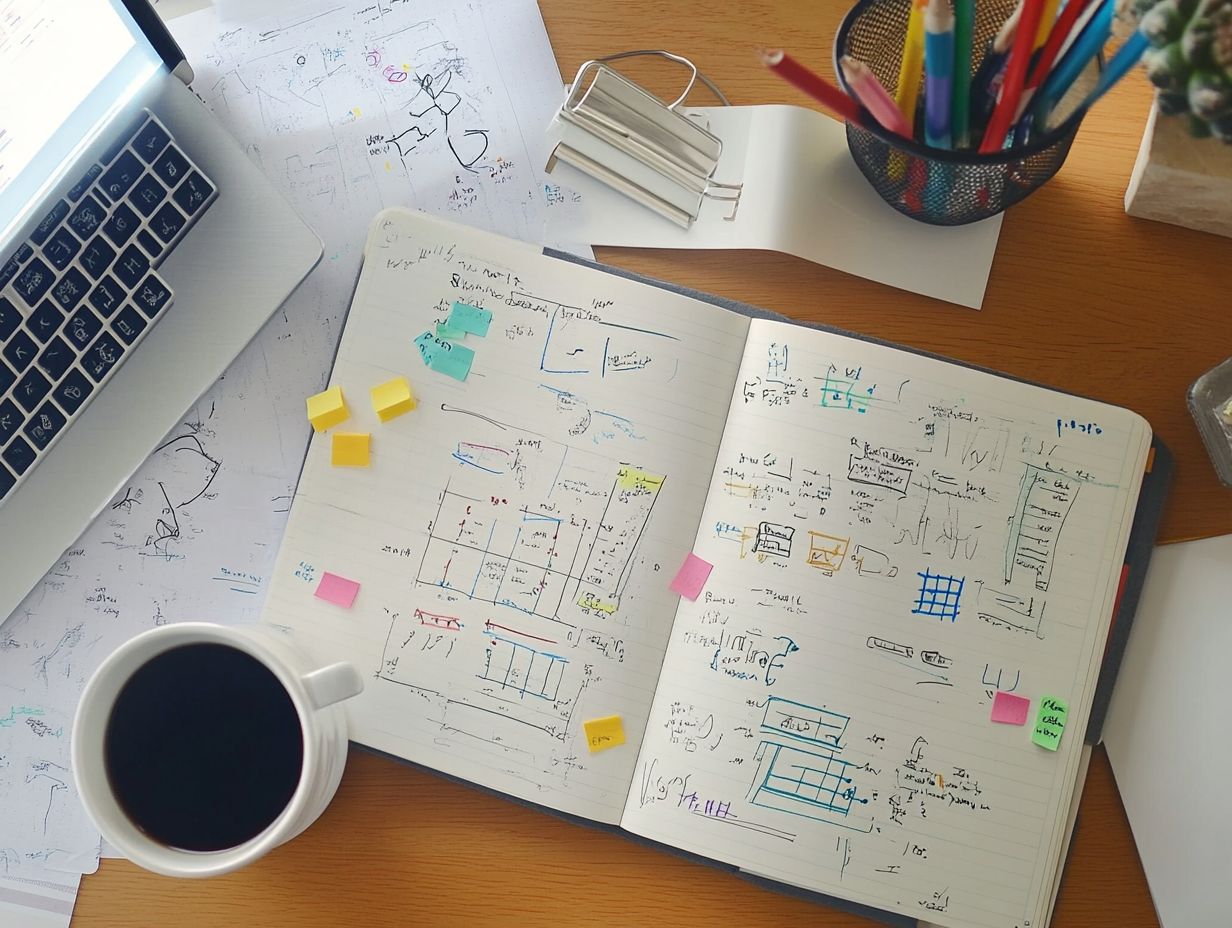How to Build a Skill Enhancement Curriculum
In today’s fast-paced world, enhancing your skills is crucial for both personal and professional growth. This guide is designed to help you navigate the process of creating a comprehensive skill enhancement curriculum.
It delves into what skill enhancement truly means, guides you in identifying the core skills you need, and helps you assess your current abilities. You ll learn how to design a customized curriculum that sets clear goals, select effective resources, and implement a learning schedule that keeps you accountable.
The guide also covers how to evaluate your progress and adjust your approach for continuous improvement. Whether you aim to advance in your career or explore new interests, this resource equips you with the tools necessary for success.
Contents
- Key Takeaways:
- Understanding Skill Enhancement
- Identifying Core Skills to Focus On
- Designing Your Curriculum
- Implementing Your Curriculum
- How to Evaluate and Improve Your Curriculum
- Frequently Asked Questions
- What is a skill enhancement curriculum?
- Why is it important to build a skill enhancement curriculum?
- How do I determine which skills to include in a skill enhancement curriculum?
- What are some common elements of a skill enhancement curriculum?
- How can I make a skill enhancement curriculum engaging and effective?
- Is it necessary to regularly update a skill enhancement curriculum?
Key Takeaways:

- Assess your current skill set and research in-demand skills to identify the core skills to focus on.
- Set clear goals and objectives and select appropriate learning resources to design an effective skill enhancement curriculum.
- Create a schedule, stay accountable and motivated, and regularly evaluate and adjust your curriculum for continued improvement.
Understanding Skill Enhancement
Skill enhancement is essential for cultivating a culture of continuous learning and growth within your organization. By aligning your skill strategies with organizational goals, you can effectively develop your employees. To ensure they have the necessary skills to adapt to industry changes and meet performance metrics, it’s important to understand how to measure skill enhancement effectiveness.
A well-defined skill enhancement approach also boosts employee satisfaction and retention, enabling HR and L&D leaders to design robust training programs focused on upskilling (training to improve current skills) and reskilling (training to learn new skills). This initiative sparks a culture of innovation and enhances stakeholder engagement through value alignment, ultimately resulting in improved employee performance.
What is Skill Enhancement?
Skill enhancement is your intentional journey toward improving and developing your capabilities and competencies through continuous learning and targeted training programs.
This isn’t just a one-off activity; it involves a variety of initiatives, including workshops, e-learning modules, and on-the-job training, all crafted to promote your professional growth. By engaging in these endeavors, you refine your existing skills and acquire new ones that are essential in today s fast-paced workplace.
Prioritizing skill enhancement is crucial for any organization looking to maintain a competitive edge. It fosters increased employee motivation, job satisfaction, and overall productivity. Implementing structured training programs can transform your workforce, making them more adaptable and ready to tackle emerging challenges in their fields.
Identifying Core Skills to Focus On
Identifying the core skills you need to focus on is crucial for effective employee development and optimized performance measurement, particularly in rapidly evolving sectors where skill demands shift frequently.
As an HR leader, you play a pivotal role in assessing your current workforce’s competencies. By utilizing a system for organizing skills, you can pinpoint the in-demand skills that align with your organization s needs and objectives.
This strategic focus not only enhances employee performance but also cultivates a culture of continuous learning and adaptation within the workplace.
Assessing Your Current Skill Set
Assessing your current skill set is an essential first step in enhancing your abilities. This process involves a comprehensive evaluation of your existing competencies measured against organizational goals and performance indicators, as well as understanding the challenges of skill enhancement.
To gain a well-rounded perspective, utilize methods such as self-evaluations, peer reviews, and performance metrics. Self-evaluations allow you to reflect critically on your abilities, while peer reviews provide valuable insights from colleagues who understand the nuances of your work environment. Performance metrics deliver concrete data that quantifies your effectiveness and highlights areas ripe for improvement.
It’s vital to align these assessment methods with a skills taxonomy framework. Doing so helps you pinpoint specific developmental gaps, ensuring that your training and support are targeted effectively. This approach ultimately fosters a workforce that is not only more skilled but also adaptable to changing demands.
In summary, enhancing your skills and developing a robust curriculum is essential for both personal and organizational growth. To get started, learn how to facilitate effective skill enhancement sessions and take the initiative to assess, plan, and implement your skill enhancement journey today!
Researching In-Demand Skills

Researching in-demand skills is vital for staying competitive. The job landscape is always changing, and so are the skills needed.
By conducting thorough labor market analyses and examining industry reports, you can uncover valuable insights into emerging trends and the skill sets that are increasingly in demand. Networking with industry professionals and attending relevant conferences will also serve you well, as these interactions often provide firsthand knowledge of the competencies that are becoming vital.
Establishing a structured feedback loop where your employees can express their skill needs will enable your organization to tailor training and development programs effectively. This approach boosts performance and energizes your team!
Designing Your Curriculum
Creating a curriculum that meets workforce needs is crucial. It requires you to establish clear learning objectives and explore how to integrate skill enhancement into daily work by choosing training programs specifically tailored to upskill your employees.
As a leader in Learning and Development, you must explore various learning platforms and resources to create a curriculum that addresses the current skills gap. This curriculum should include skill enhancement programs that foster employee development and equip them for future challenges in the workplace.
Setting Goals and Objectives
Setting specific and measurable goals and objectives is essential in any skill enhancement initiative, providing you with a clear roadmap for your development and allowing for accurate performance measurement.
Using the SMART framework helps you grasp your goals and equips you to achieve them. For example, if you’re aiming to improve your project management skills, a concrete objective might be to complete an online certification course within three months, with success measured by obtaining that certification.
Aligning your performance goals with your organization’s strategies can create more relevant learning experiences, such as honing customer service techniques to enhance client satisfaction scores. By establishing time-bound deadlines, you stay motivated, focused, and accountable, ultimately driving both your personal growth and that of the organization.
Selecting Learning Resources
Choosing the right learning resources is key to enhancing your skills, as they significantly impact the effectiveness of training programs designed to upskill employees.
In today s fast-paced world, leveraging a combination of online courses, interactive workshops, and mentorship programs allows you to cater to various learning styles and paces, making your education more personalized and effective. Online platforms have transformed the way you access knowledge, offering a wealth of training materials that enable you to acquire new skills at your convenience.
Workshops provide immersive experiences that encourage hands-on practice, while mentorship programs connect you with industry professionals who offer valuable guidance and insights.
This diverse selection of resources ensures you can find the training that aligns perfectly with your career goals.
Implementing Your Curriculum
To implement your curriculum well, follow a well-organized plan. This involves crafting a comprehensive schedule, establishing clear accountability, and nurturing a sense of ownership among your employees.
Such strategies not only enhance employee satisfaction but also significantly boost engagement levels.
Creating a Schedule

Creating a training schedule that aligns with your organization s priorities and employee availability is crucial for maximizing engagement. It ensures effective curriculum delivery.
By integrating flexible timing options, you can cater to different ways people learn and personal commitments. It’s essential to assess peak productivity hours and align training sessions accordingly to minimize disruption in workflow.
Incorporating employee feedback fosters a sense of ownership and leads to higher participation rates.
Balancing rigorous training with breaks is vital. This helps maintain energy and focus throughout the learning process. Ultimately, finding that sweet spot between organizational needs and workforce preferences enhances overall training effectiveness.
Staying Accountable and Motivated
Staying accountable and motivated throughout your skill enhancement journey is crucial for achieving the outcomes you desire. Structured mentoring programs and regular check-ins can effectively support you in staying on track.
Establishing a solid framework for mentorship is just the beginning. Incorporating peer support systems significantly strengthens your resolve.
Engaging in group training sessions or study groups creates a sense of community. Here, you can share challenges and celebrate milestones with others.
Maintaining a progress tracking mechanism, like a daily or weekly log, nurtures self-awareness and encourages reflection on your growth journey.
By actively monitoring your achievements and setbacks, you’re better equipped to adjust your strategies. This ensures you remain focused, motivated, and accountable to your goals.
How to Evaluate and Improve Your Curriculum
Evaluating and adjusting your curriculum based on feedback and progress measurement is vital for ensuring its effectiveness and relevance. This process aligns with your organizational goals and significantly contributes to employee development.
By taking the time to assess and refine your approach, you foster a more engaged, skilled, and adaptable workforce.
Measuring Progress
Measuring progress is essential in your journey of skill enhancement. It enables you to evaluate training outcomes and pinpoint areas that require further development through relevant performance indicators.
By implementing a variety of assessment methods, you can enrich this process. Regular assessments, such as quizzes and practical evaluations, provide immediate insights into your learning trajectory.
Feedback surveys capture your experiences and perceptions, fostering a culture of open communication.
Performance reviews act as a comprehensive tool where you can discuss your progress with supervisors. This aligns your personal goals with the broader organizational objectives.
Together, these methods track your growth and guide your continuous development. This ensures that you evolve in harmony with both your aspirations and the company s needs.
Making Changes for Continued Improvement
Making adjustments based on evaluation results is crucial for the ongoing enhancement of training programs. This ensures they remain aligned with both employee satisfaction and the evolving needs of the business.
Diving into feedback and performance data allows you to pinpoint specific areas where your employees may be struggling or excelling.
This process is an exciting team effort that transforms your training!
By integrating these insights, you elevate the quality of training and foster a culture of growth.
This commitment to continuous improvement enhances the effectiveness of your employee development initiatives, driving overall organizational success. Skilled and competent individuals make significant contributions to team objectives.
Frequently Asked Questions

What is a skill enhancement curriculum?
A skill enhancement curriculum is a clear plan that outlines the skills and knowledge needed to boost performance in a specific area, and understanding how to choose the right skill enhancement program can make all the difference.
Why is it important to build a skill enhancement curriculum?
Creating a skill enhancement curriculum helps identify improvement areas. This targeted approach can increase productivity and overall success, especially when you understand how to create an inclusive skill enhancement program.
How do I determine which skills to include in a skill enhancement curriculum?
Start by defining your goals and objectives. Then, evaluate the necessary skills to meet those goals.
What are some common elements of a skill enhancement curriculum?
A solid curriculum includes learning objectives, teaching strategies, assessment methods, and a timeline. You might also want to add resources like textbooks and online courses.
How can I make a skill enhancement curriculum engaging and effective?
Incorporate various learning methods, such as hands-on activities and group discussions. Tailor it to fit each person’s learning style and ensure there are chances for practice and feedback.
Is it necessary to regularly update a skill enhancement curriculum?
Regularly reviewing and updating the curriculum is essential. As industries and technologies change, the skills required for success may shift, so keep it relevant!






